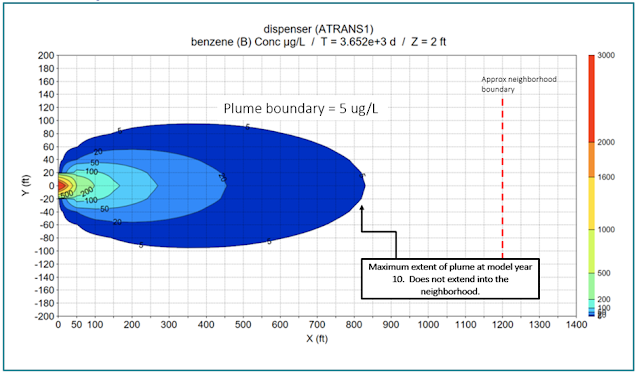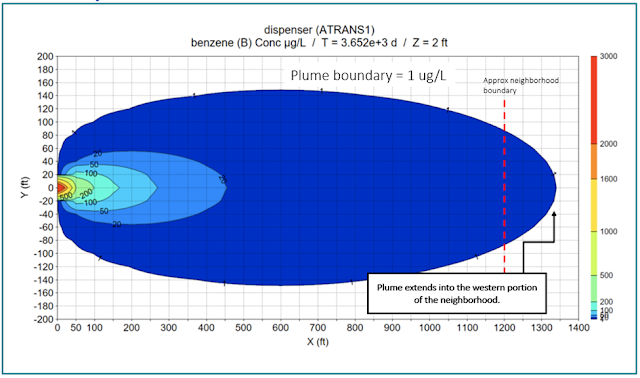TS-CHEM is not only simple and easy to use, but it can be applied
to a number of different common situations
when it comes to impacted groundwater, making
it the perfect tool for environmental professionals who perform groundwater
investigation and remediation activities. To show how TS-CHEM can be used to
evaluate a number of common groundwater issues, we have created a series of
Example Applications. In this blog post,
we introduce the first Example Application in the series, which demonstrates
how TS-CHEM can be used to model the length of a contaminant plume (in this
case a benzene plume) in order to determine if it will impact domestic wells at
a nearby residential development. You can download the model files and
accompanying overview slide deck for the example application described below HERE.
Overview
In Example Application 1, there has been a small
leak beneath a dispenser island at a gasoline station. This leak has led to a
release of benzene into the groundwater below the site with the source
concentrated near monitoring well MW-4. A residential development is located
1200 ft (1/4 mile) away from the leak location, and there is concern as to
whether domestic wells may be impacted by benzene. TS-CHEM can be utilized to determine whether the
dissolved benzene plume from the dispenser release will reach the domestic
wells above the drinking water standard of 5 ug/L.
 |
| Fig 1. Site map showing the distance from the benzene source at the dispenser island to the residential area. |
Setting up The Model
Considering the benzene release recently occurred and no
remediation has taken place yet, we want to treat the contamination source as
constant source rather than a decaying or transient source. Therefore, ATRANS1
is the perfect model solution for this scenario since it is a continuous and
constant source model, and it will allow for a conservative evaluation of the
maximum extent of the benzene plume.
Once we’ve chosen ATRANS1 as our model solution, we need to
input all of the necessary model parameters that have been measured or
estimated from a preliminary investigation of the station, as shown below:
- Hydraulic gradient = 0.003 ft/ft
- Hydraulic conductivity = 60 ft/d
- Effective porosity = 0.25
- Benzene source concentration = 3,000 ug/L
- Source width (width of dispenser island) = 10 ft
- Source depth (smear zone thickness beneath water table) = 2 ft
Analysis 1
First, we set two model observation points
downgradient from the source at 600 ft and 1000 ft away. This will allow us to
view the rise and stabilization of the benzene plume at these locations. Next, we
run the model for a duration of 10 years. Once the model is finished running, we
can display the concentration versus time (C v t) chart:
 |
| Fig
2. The C v t chart in TS-CHEM displaying benzene concentrations near the source
at MW-1 (dark blue), 600 ft from the source (aqua), and 1000 ft from the source
(red). |
The dark blue line shows that benzene concentrations at MW-1
where groundwater leaves the station property stabilize at around 76 ug/L,
while our observation points we set at 600 ft and 1000 ft show benzene
concentrations stabilizing around 11 ug/L and 3 ug/L, respectively. This chart
shows how the stabilized concentration of benzene decreases as you move further
away from the gas station.
Now, let’s take a look at our contour chart set
to model year 10: |
| Fig
3. TS-CHEM’s contour chart indicates that the maximum plume extent (bound at 5
ug/L) does not reach the residential area. |
In the chart above, we’ve set the plume boundary to 5 ug/L,
which in this example, is the applicable drinking water standard for benzene.
Notice how the maximum extent of the plume does not reach the neighborhood
under these model conditions. In this case, one might conclude that based on the
results of the analysis, the benzene contamination at the gas station does not
impact receptors (domestic wells).
Analysis 2
As noted above, the initial analyses performed using ATRANS
1 indicate that groundwater concentrations are not likely to reach downgradient
receptor wells above 5 ug/L. However, let’s say that local regulations impose a
different standard, and we must now evaluate a drinking water standard for
benzene of 1 ug/L. Accordingly, we will need to perform an additional analysis
to evaluate whether downgradient receptor wells may be impacted at
concentrations above 1 ug/L.
Since nothing at our site has changed (including
aquifer characteristics, source concentrations, and source size), we just have
to adjust our outer plume contour from 5 ug/L to 1 ug/L. Once we’ve changed the
plume contour, we can re-examine the contour chart at model year ten: |
| Fig 4. TS-CHEM’s contour chart indicates that the benzene plume, with a boundary of 1 ug/L, will impact the residential area. |
As shown in Figure 4 above, the plume visibly extends much
further to the east than it did in Analysis 1 (Figure 3), and therefore, our
conclusion has changed; under this more stringent drinking water standard, the
benzene spill at the gas station may impact downgradient receptors. But as
noted above, these analyses are very conservative. What if more reasonable inputs are used?
Analysis 3
 |
| Fig 5. The C v t chart in TS-CHEM shows that benzene concentrations stabilize at a much lower level when the degradation rate is increased. |
As
shown in Figure 5
above, the C v t chart shows that benzene stabilizes around 35 ug/L at MW-1
near the station property boundary, which is about half the concentration
observed in the previous analyses. Additionally, the benzene barely registers
at our downgradient observation points. Now let’s look at the contour chart to
examine the maximum extent of the plume using this higher degradation rate.
 |
| Fig 6. The contour chart demonstrates the effect of increasing the degradation rate of benzene. The plume, while still bound at the more protective 1 ug/L, no longer impacts the residential area. |
Review of contour charts for each model year indicates that the benzene plume stabilizes in less than 4 years, which is about half the time it took the plume to stabilize in the previous analyses. Also, the plume, bound at 1 ug/L, reaches a maximum length of approximately 580 ft, and thus, does not impact the neighborhood domestic wells. The length of the benzene plume observed in this analysis is consistent with benzene plume lengths seen in many literature studies such as API 1998 and Connor et al 2014.
Why is this important?
In the case of a leak or spill of hazardous substances,
government agencies may require some form of receptor impact evaluation in
order to protect people and ecological receptors from exposure to
contamination. TS-CHEM is a quick and easy, and science-base, way for any
environmental professional to assess potential risks to receptors, evaluate the
effect of changes in input parameters, and support decisions regarding the
possible need for remedial actions. With over 30 solution models to choose from
and a library of the most commonly modeled constituents, you can select an
appropriate model and quickly (and easily) perform a receptor impact evaluation
at your site!
To learn more about TS-CHEM, or to download a FREE DEMO of the software,
visit the TS-CHEM Website! If you
would like to see what else TS-CHEM can do, check out our other Example
Applications!
No comments:
Post a Comment